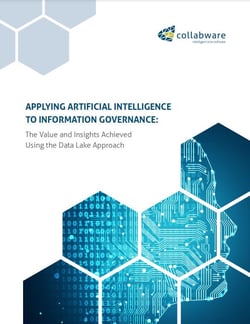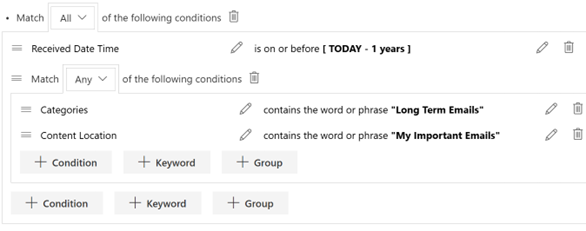 Image shows AI, personified. Courtesy of Shutterstock images.
Image shows AI, personified. Courtesy of Shutterstock images.
Forget killer bots plotting our demise. Collabware CEO Graham Sibley explained that the way Artificial Intelligence (AI) runs is incredibly simple and when properly utilized, can help organizations save money and allow employees to work more productively.
Spoiler alert: AI is programming an algorithm to answer questions with a YES or NO, which automates and streamlines day-to-day tasks. But more on that below.
- What is AI and how does it work?
- Two categories of AI
- Basic types of algorithms
- Why AI for information management?
- What can AI do for Records Managers?
- A case study showing how AI can provide organizational value
- Factors to consider before adopting AI
What is Artificial Intelligence and How Does it Work, Really?
Daunting as it may seem, Graham stated that AI is simply teaching machines to learn so they can make decisions. To express the intelligence and makes decisions our brain normally would.
The basic concept of how AI works is Yes-No decision making. This process can be broken down into three steps:
- Input data
- AI performs an analysis against criteria, aka algorithms (see basic types of algorithms, below)
- AI Determines 'yes' or 'no' and proceeds accordingly
Sounds too easy to be true? It really is that straightforward.
While AI appears to be extremely intelligent at times, the truth is that each and every basic fundamental building block is based on whether yes or no is determined. In this way, the reality is less 'planet destroying robots' and more like our old friend Clippy (pictured to your right, remember him?) who is programmed in a way that can help us at work.
Two Categories of AI
As for what AI exists today, two categories were listed in the presentation:
-
AI for interaction:
This category can be used for exchanges with AI for tips, locations, info bits. Think Alexa or Siri.
-
AI for content:
These can be used to classify data such as text or documents, for entity extraction to pull out useful information using algorithms in order to refine, or as image extractors that can compare images of, for example, mining machinery to track equipment maintenance levels.
Graham also spoke on algorithms, providing definitions of decision trees and clustering/similarity. As a bonus here, we’ve done you a solid and listed out basic descriptions for all of the types listed during the tech talk!
Basic Types of Algorithms
Algorithms are the step-by-step procedures, or set of instructions, that AI use to perform analysis against criteria before making its YES or NO decision.
There are many types of algorithms, including:
- Regression: this algorithm predicts output values based on input features fed into the system. It's useful to predict numbers, for example, using property location and size to predict real estate value.
- Instance-based: these generate predictions using specific instances or examples of training data. They are also known as 'memory-based learning' algorithms.
- Regularization: this type of method works in a way that favors simpler, generalizing models.
- Decision trees: this method was touched on by Graham in the video and is constructed into a tree based on its decisions, which fork into tree-like structures.
- Bayesian algorithms: these apply Bayes' theorem, which uses previous data evidence to update the probabilities of hypothesis, and are often used as spam filters for email.
- Clustering and similarity: both algorithms organize data into groups of commonality using the data's inherent structures. Graham provided the example of similarity algorithms being useful to find document similarities and keywords, while clustering would be able to extract and group these common terms.
- Neural networks: these interesting models are pattern matching and often times used for regression or classification problems. They are inspired by the functions of biological neural networks!
- Last but not least, Deep Learning algorithms are essentially a modern update of the original neural networks. These include bigger and more complex neural networks and are great when deployed onto large data sets that contain very little labeling.
And more! See the end of this blog post for more information.*
Why AI for Information Management? 'The Big Content Problem'
So you might be thinking: Okay, great. But implementing AI at my office? Why is that necessary?
Graham included this quote to bring some insight:
"Every two days we create as much information as we did from the dawn of civilization up until 2003"
-Eric Schmidt
The current volume of information out there is literally in-comprehensible to human beings. Try to imagine for a moment, sorting through a years' worth of work-related files and documents on the devices of employees throughout your organization. Overwhelming is an understatement.
 This pyramid is a visual representation of how extensive 'big content' can get throughout an organization.
This pyramid is a visual representation of how extensive 'big content' can get throughout an organization.The solution? As Graham said in his presentation, "we need to get to the point where machines can express the intelligence our brain can express so that it can do that [overwhelming] work for us."
What Can AI do for Records Managers?
The value of using AI in your organization? Graham listed these following three examples:
- Automatic classification of content: This includes metadata, security, and retention. While auto classification has been around for a while (ex: text classifiers), it has improved over time.
- Automatic identification of key data: The ability to extract people, places, and things from information. For example, with location extraction AIs are able to show 'documents near me'.
- Identification of value: Discovering information based on implicit relationships is a feature still in the works, however it will allow individuals to understand how pieces of content are meaningful and to find the value in documents for improved business functioning.
Case Study: How Artificial Intelligence Shows Organizational Value
Incorporating artificial intelligence into documentation operations can result in major ROI. For example, AI-based automated filing can save 3.5 minutes per document once deployed, which is a 900K investment for a 2,850,000 dollar ROI over 3 years.
 Chart shows ROI of AI-based Automated Filing (900K investments for 2,850,000 dollar ROI over 3 years.)
Chart shows ROI of AI-based Automated Filing (900K investments for 2,850,000 dollar ROI over 3 years.)
Graham also provided the example of a multinational grocery retailer unlocking new value from existing content through pattern analysis. In this case, the retailer used AI in order to learn that they spent a lot on cooling, and used that information to save twenty million dollars that year via cooling reduction.
Factors to Consider Before Adopting AI
Graham's tech talk included the following four factors to consider when trying to adopt AI:
-
Know where your content is:
- Where do you store your content? Create a list of locations, identify the type and volume of content
- Can it be indexed and computed from the location?
- If not, can you copy/move it to somewhere else that can be computed?
-
Identify the most important decision-making capability you require:
- Do you need to find specific content?
- Do you need to organize the content?
- Do you need to protect the content?
-
Determine how you want your users to interact with your AI:
- Do you want users to search/chat with the AI? (Like Siri or Alexa)
- Do you want your AI to be transparent? (Behind the scenes)
-
Finally, select the tech you want to use to develop and support your AI
Conclusion
The workings of artificial intelligence are actually quite simple (programming machines to make yes-no decisions), and can be utilized in a way that makes your organization’s documentation and information management less daunting.
We've got the entire PowerPoint presentation available below. Want to learn how to implement AI for your information management? We've got a free whitepaper on that, also available below! We have also written all about how content enrichment uses AI, machine learning and more to bring value to your organizational processes. Feel free to contact our team with any questions, our focus is on providing solutions and services to help organizations overcome information chaos and gain valuable insights from their stored data.
To see the entire PowerPoint Presentation, click here to download a printable PDF:

*To learn more about algorithm types, check out this Tour of Machine Learning Algorithms by Machine Learning Mastery.






